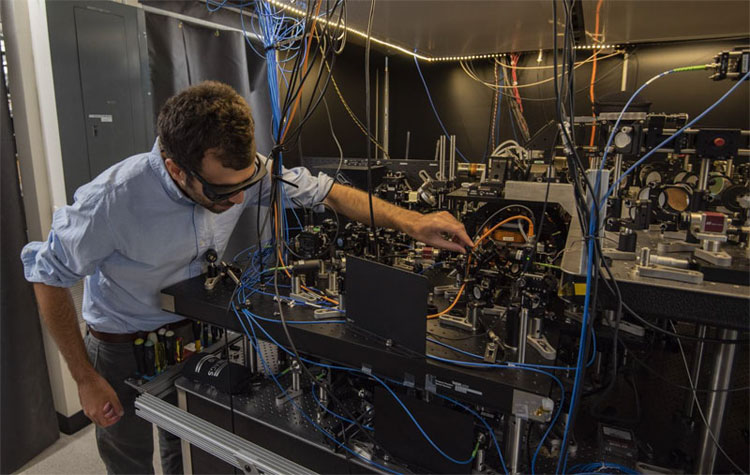
Optical Clock Uses Laser Tweezers to Manipulate Atoms
BOULDER, Colo., Sept. 20, 2019 — JILA physicists have demonstrated a new atomic clock design that uses laser tweezers to trap, control, and isolate atoms. The tweezers are created by an IR laser beam aimed through a microscope. The beam is deflected to create 10 spots of light for trapping individual strontium atoms. The traps are refilled every few seconds from a prechilled cloud of atoms overlapped with the tweezer light.
The atoms held by the tweezers are excited by a laser that is stabilized by a silicon crystal cavity, creating a "clock laser" light. This light is applied perpendicular to the tweezer light along with an applied magnetic field. Nondestructive imaging reveals whether the atoms are ticking properly; the atoms will emit light only when in the lower-energy state.
The tweezer clock traps and controls atoms individually to maintain ticking stability. It can reuse the same atoms many times without needing to constantly reload new ones. “The tweezer design addresses various issues with other atomic clocks,” physicist Adam Kaufman said. “Using our technique, we can hold onto atoms and reuse them for as long as 16 seconds, which improves the duty cycle — the fraction of time spent using the atoms’ ticking to correct the laser frequency — and precision.”
Too many atoms in the system can lead to collisions that destabilize the clock. To eliminate unnecessary atoms, the researchers apply a pulse of light to create weakly bound molecules, which break apart and escape the trap. The tweezer site is then left either empty or with only one atom. Having at most one atom per site keeps the ticking stable for longer periods of time. Also, the tweezer clock can isolate a single atom in a trap site very quickly, thereby reducing interference and providing a more stable signal over time.
In experiments, the researchers observed coherence times of 3.4 seconds and duty cycles up to 96% through repeated interrogation. The tweezer clock requires little downtime to prepare new atoms. The atoms are well isolated to be less likely to interfere with one another.

JILA/NIST physicist Adam Kaufman adjusts the setup for a laser that controls and cools the strontium atoms in the optical tweezer clock. The atoms are trapped individually by 10 tweezers — laser light focused into tiny spots — inside the square orange container behind Kaufman's left hand. Courtesy of Burrus/NIST.
The tweezer clock can provide the strong signals and stability of a multiatom lattice clock. “The tweezer design’s long-term promise as a competitive clock is rooted in its unique balancing of these capabilities,” Kaufman said.
The laser tweezers offer pinpoint control, allowing the researchers to vary the spacing between atoms and tweak their quantum properties. The tweezers can be used to excite the atoms so their electrons are more weakly bound to the nucleus. In this “fluffy” state, the atoms can be trapped in magnetic spin-up and spin-down states more easily, and become entangled through spin exchange. Quantum states such as entanglement could improve measurement sensitivity and thus enhance clock precision.
The National Institute of Standards and Technology (NIST) team is helping to prepare for the future international redefinition of the second, which has been based on the cesium atom since 1967. The team now plans to build a larger clock and formally evaluate its performance using more tweezers and atoms, with a target of about 150 atoms. Kaufman also plans to add entanglement, which could improve clock sensitivity and performance and, in a separate application, perhaps provide a new platform for quantum computing and simulation.
The research was published in Science (https://doi.org/10.1126/science.aay0644).
Published: September 2019